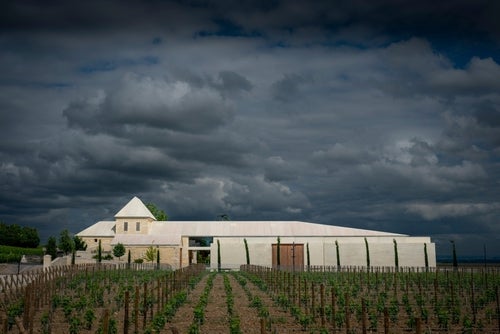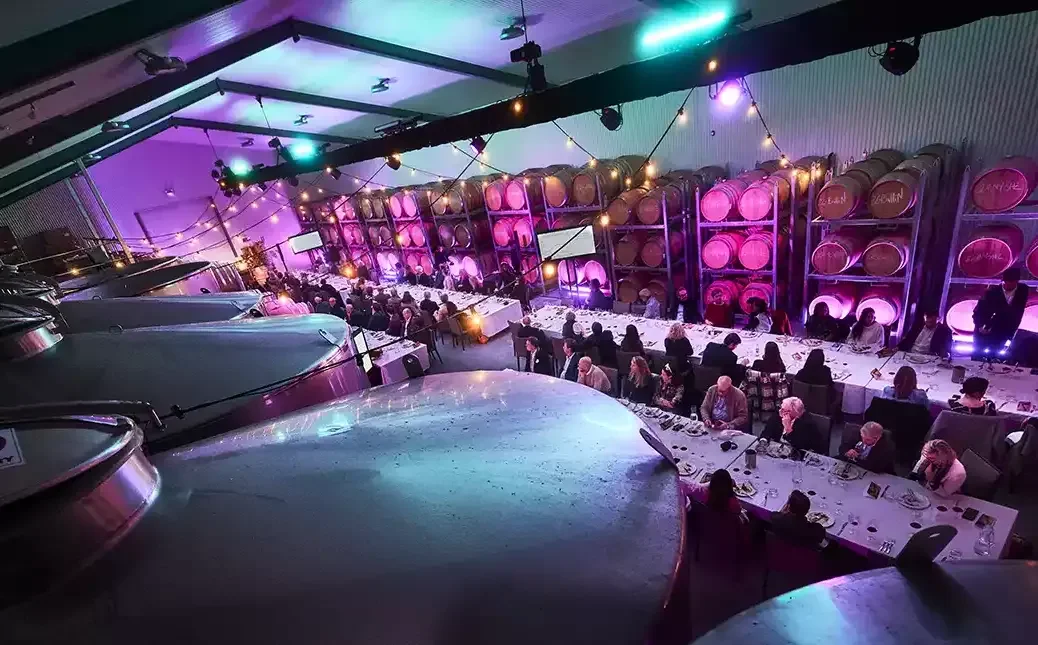
A little over a decade ago, we looked at a special tasting of Clonakilla Shiraz/Viognier, held to celebrate its 40th anniversary (see WFW 39, pp.58–63). Now, we can repeat the exercise, and more, for the 50th. I say, “a little over,” as the original timing was Covid-affected, as so much has been. Fortunately, Tim Kirk and his family did not abandon their plans. They just kept rescheduling—it turned out to be third time lucky.
Why is it worth looking at this wine? Put simply, Clonakilla Shiraz/Viognier sits with the very finest wines produced in Australia. For me, it’s one of our four greatest reds, alongside Penfold’s Grange, Henschke’s Hill of Grace, and Cullen’s Diana Madeline Cabernet Sauvignon. Several are certainly snapping at their heels—Brokenwood’s Graveyard, the top Pinot Noir from Bass Phillip and Bindi, and Wynn’s John Riddoch. There are others, too, all of which would no doubt feel aggrieved to have missed the cut.
Clonakilla is the leading winery in the Canberra region, as it always has been, making a number of superb wines in addition to its Shiraz/Viognier. The Kirk family are regional pioneers, and Tim Kirk is a supremely talented winemaker.
Briefly, to recap for those not overly familiar with Canberra or its wines, this small city is Australia’s capital. After federation in 1901, the location for the site of the new capital was finally decided in 1909. Prior to that, this was home to local indigenous people (canberry meant meeting place in their dialect) and squatting stockmen. A strange choice—though many might suggest no stranger than anything else relating to it. As children, we were taught the decision was made as neither Sydney nor Melbourne would agree to the other being named capital, and this was a midway point. Actually, it is much closer to Sydney but still far enough from everything for that not to matter. Exactly the sort of bureaucratic snafu one might expect.
Canberra can be bitterly cold in winter and searingly hot in summer, but it is characterized, as a generalization, by warm days and cool nights. The annual rainfall is slightly over 24in (600mm). The bright natural acidity, in no small part attributable to the significant diurnal fluctuation in temperatures, has proved crucial in making quality wines.
There are some 140 vineyards in the region, which actually spills out of the designated Australian Capital Territory and into the neighboring state of New South Wales, and several dozen wineries.
The genesis (not an inappropriate moniker given what was to come) of Clonakilla dates back to Britain in the 1960s and an Irish biochemist who studied at both Oxford and Cambridge, Dr John Kirk. John ensured that family holidays were back in Ireland, on the Kirk family farm, called Clonakilla, in County Clare. He had always harbored a desire to be a simple farmer, but as a renowned scientist, that was unlikely to eventuate.
John’s introduction to wine dated back to World War II, when, as a 14-year-old, he worked in the family pub, the Hydro Hotel in Lisdoonvarna, County Clare. One of young John’s tasks was managing the cellar. It comes as no surprise to learn that someone who became such a respected scientist decided that he needed to research his subject. Consequently, John purchased “the best book on wine available,” which at the time was by André Simon. John became, as he put it, “a non-drinking, teenage expert.”
In 1968, a research position became available with the Commonwealth Scientific and Industrial Research Organisation’s Division of Plant Industry. John had relatives who had emigrated to Australia some time earlier—though given that it was more than a century earlier (during the gold rushes), one wonders how close they were—so he and his wife packed up, with their four children—all sons and they would have two more (bizarrely, that led to 13 granddaughters and then eight great-grandsons)—and headed for Canberra. At this time, there were no vineyards in the region. Conventional wisdom and local belief both insisted that the climate was too cold for grapes. John was not convinced. In fact, he was so certain that conditions were ideal for wine grapes that he finally became that farmer, at least in his spare time. In 1971, he purchased a 44-acre (18ha) farm at Murrumbateman, a little to the north of Canberra. Here he planted Cabernet Sauvignon and Riesling.
Actually, he planted 600 vines of both Cabernet and Riesling, with 12 vines each of Shiraz, Pinot Noir, and Traminer. That might seem a strange choice now, but back then very few wine drinkers in Australia had a clue what Chardonnay was. 1971 was the same year Tyrrell’s made what would become the first commercial release of Chardonnay in the country, albeit in tiny quantities. Riesling was widely planted and considered our leading white variety. Cabernet, meanwhile, was the undisputed heavyweight red variety. Traminer was usually blended with Riesling. Pinot Noir would do little more than draw blank stares. Shiraz was well known and prolific, but in those days—notwithstanding the efforts of Penfolds with its Grange Hermitage—it was rarely seen as anything other than a workhorse, a variety to be added to Cabernet and one that was suitable for anything from rosé to fortifieds, sparkling reds, cask wine, or even muffins.
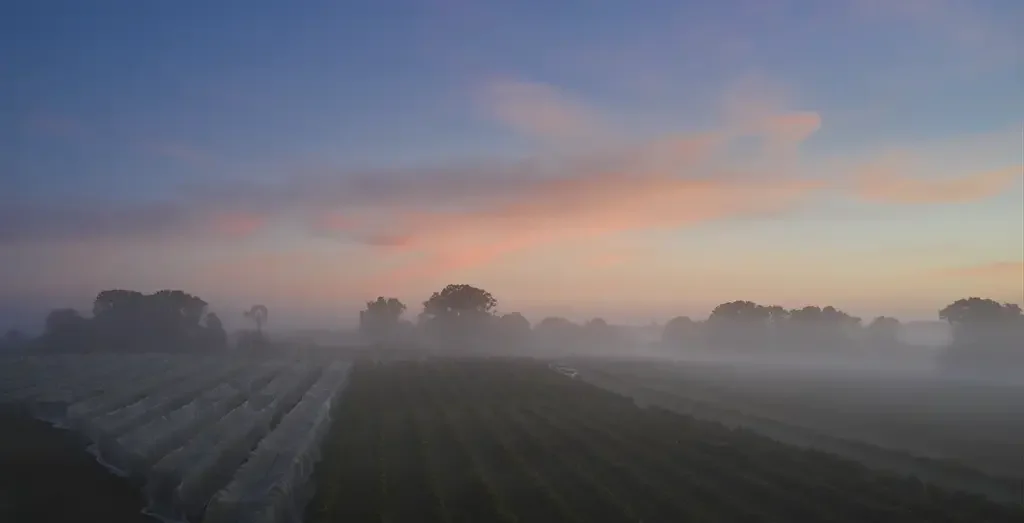
The search for an enduring niche
In 1976, John released his first wines, a Riesling and a Cabernet/Shiraz blend. Tim’s brother Jeremy felt it necessary for the family to establish a niche in the market. In 1986, he persuaded his father to plant Viognier. At the time, it was virtually unheard of in Australia (or elsewhere). It is surprising that they were even able to source any vines. They discovered that there was a grand total of two vines at nearby Wagga Wagga—where most Australian winemakers were trained—and convinced the staff to allow the family to take some cuttings. It is impossible to think of anything that would have been more niche at the time.
The family did not even bottle a straight Shiraz until 1990. Even then, it was made in such small quantities that it was not eligible for entry in the Sydney Wine Show. It did, however, qualify for the local-ish Griffith Show, where, to everyone’s surprise, it won Best Wine of the Show. Dr John’s reaction was simple: “That was the end of the end of the Cabernet/Shiraz.” But it was still a long journey for it to become this country’s leading Shiraz/Viognier.
Giving the landscape a voice
Some years ago, the country went through a fad where every winery in Australia had a Shiraz/Viognier. Sadly, far too many incorporated far too much Viognier, creating blends that looked more like a curious apricot juice than a recognizable wine. Today, it is rare even to see “Viognier” on a red-wine label, such was the backlash. Clonakilla is one of the few exceptions, but it all took time.
Shortly after the success of the Shiraz at Griffith, Tim decided to visit the Rhône Valley, on the suggestion of a local scribe, to learn more about Shiraz/Syrah. Tim, now a grandfather himself, originally trained in theology—the Church’s loss is wine’s gain—but left in 1996 to join his father full time, eventually taking the reins. Tim is not the only sibling involved in wine. Brother Kiaran, dean of the College of Science at the Australian National University (located in Canberra) is the successor to Louisa Rose as chair of the Australian Wine Research Institute. Jeremy, who made the inspirational decision to plant Viognier, is a Supreme Court judge in NSW.
While Tim will happily talk about the glorious 1990 La Chapelle from Jaboulet, the wines that made a real impression were the Côte-Rôties of Guigal. Suddenly, those Viognier vines had a purpose. Something about mysterious ways springs to mind. Tim simply smiles and looks to the heavens—“Tell me there is not a God”—in a way that would make famous atheists like Ernest Hemingway and Richard Dawkins believe.
In 1992, Clonakilla made its first Shiraz/Viognier. It was one of the very first made in Australia and included only 1 percent Viognier, but it had been pipped by Yarra Yering in the Yarra Valley. Clonakilla, however, quickly established itself as the leading maker of this style—and has remained so to this day. Tim spoke about how Viognier was not the only thing added in those days. The wines would often enjoy a contribution from Pinot Noir, and the 1992 even included a dollop of Mataro. The different varieties are always co-fermented.
Over the years, Tim has ascertained what works to ensure the best wine possible. As for the inclusion of Viognier, 1 percent is too little, and 10 percent is too much. It seems that 5–7 percent is the sweet spot. New oak is important—but never more than one third. The oak is all French these days, because they believe it suits their aim for more delicate wines. Since 1993, they have used whole bunches, usually one third, though they are not dogmatic about this. The 2011, for example, saw none; 1994 saw 100 percent.
Tim’s aim is to “give the landscape a voice,” with all that entails. He sees raspberries and strawberries as key flavor components, “a celebration of redness.” He sees Shiraz as “inherently an aromatic variety.”
The move to screwcap happened gradually. Up to and including the 2002, the wine was always under cork. For the next four years, Tim bottled some under cork, but moved incrementally to screwcap. Since 2007, all of the wine has been under screwcap.
Tim’s work has resulted in an impressive collection of wine bling—awards, medals, and trophies—but also a fan base utterly committed to every SV release. Tim and that fan base have a relationship rarely encountered. The 2011 vintage, which was awful in much of Australia, left the winery with a pitiful quantity of its prized SV, meaning that 300 regulars would miss out on an allocation. Tim rang every one of those 300 customers himself to explain. As he said, he went “from theological student to grief counsellor” that day.
If any further evidence was needed of just how highly Tim is respected throughout the industry, when the family held the 50th (even if it was technically the 51st or 52nd) anniversary, many of those present were other winemakers, some of the most highly regarded in the country: Bruce and Chris Tyrrell, Stephen and Prue Henschke, Louisa Rose, Pat Carmody, Tom Carson, Stuart Hordern, Ian McKenzie, Charlie Melton, Ken Helm, Julian Castagna, Dave Bicknell, Michael Dhillon, Sam Middleton, Sarah Crowe, Steve Pannell, and others.
The event included 21 vintages of the Riesling, seven of the straight Syrah, seven of the single-site wines based on Shiraz, and another seven mixed Clonakilla wines matched with international benchmarks at the dinner that evening, but the highlight was undoubtedly the 21 vintages of the Shiraz/Viognier, between 1995 and 2021, which are the focus here.
Among the other wines, the 1997 Riesling looked superb, though some of those attending felt that the 1994 pipped it. The 2021 was probably the pick of the Clonakilla Rieslings, along with 2016. Riesling from Canberra rarely gets the acknowledgment it deserves—par for the course for a region that is far more appreciated by locals than by the rest of the country and certainly by offshore wine lovers. Among recent versions of the Syrah, the 2019 was the star, just ahead of the 2015. From older examples, the 2009 sung.
The Shiraz/Viognier wines were not shown in chronological order. Rather, Tim divided them into three groups—the Cool Years (“Luminous”), the Temperate Years (“Ethereal”), and the Warm Years (“Glow”). I have attempted to include anything of interest from the previous event in the notes. The latest release of the SV is the 2022, at around A$120. The winery is offering magnums of the brilliant 2021 for A$250, but it is hard to imagine that they will last long.
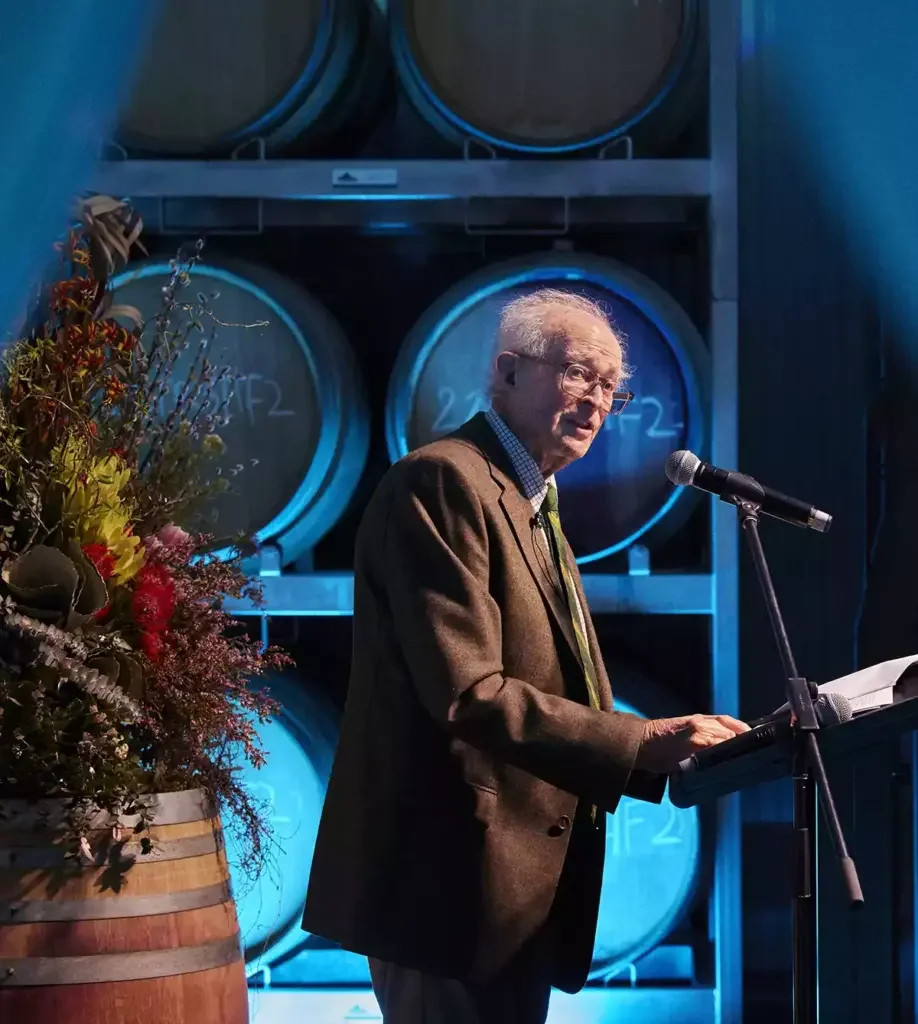
Tasting
Luminous (Cool Years)
1995 Clonakilla Shiraz/Viognier Cool and wet, this was the first year where the Viognier vines, nearing their tenth year, finally provided a reasonable harvest. The blend was 80% Shiraz, 10% Pinot Noir, and 10% Viognier. The Pinot and one third of the Shiraz were fermented as whole bunches. Maturation was in new and second-use French oak (Seguin Moreau and François Frères—Allier and Tronçais), with a small proportion of American oak also involved.
A blood-red hue to this beautifully mature and complex red. There is flesh, game, dried herbs, warm earth, and the remnants of red fruits. Still wonderfully alive. A nice line of acidity and fine tannins, though the wine is a bit grippy. Minerally, chalky backing. Good length. This is a drink-now prospect, but there is no great hurry. It certainly stood up better than the bottle we’d seen a decade earlier, which exhibited a little Brett—no sign of that here. | 92
2002 Clonakilla Shiraz/Viognier 30% whole-bunch and 6% Viognier. A year in oak, one third new Sirugue, plus François Frères and Bossuet. Tim saw this “as the most Burgundian of our wines,” and on the previous occasion as “red wine with mulch,” though that was meant as a positive. Cork taint has caused issues in the past, but no sign of that this time.
Deep red, still a hint of olive on the rim. Fragrant nose, with good depth of flavor. Mature and complex, but still fresh. Floral notes, undergrowth, animal skins, and briary characters. There is fresh acidity here and good grip, with length, but it is probably just starting to edge apart at the end. Again, a drink-now style, but no real urgency. | 91
2010 Clonakilla Shiraz/Viognier Tim notes this as the year the drought finally broke. Rain began on Christmas Day (in 2009) and went to harvest, off and on. Picking was in between the rains. 20% whole-bunch, 5% Viognier.
Quite a luminous red, with spices to the fore in the lifted aromatics. Fresh notes of red fruits. Cherries, raspberries, warm earth, game, and flesh. Do we have hints of the Viognier in the stone-fruit scent? Endless spices, hints of pepper, and some leather. Appealing texture; supple, seductive, and seamless. Quite exquisite. Fine line of acidity. There are red fruits and smoked meats, cherries and coffee grinds on the palate. Still has a decade ahead of it, which is interesting, because on the previous occasion, it did not suggest such a long life. A cracker. | 96
2011 Clonakilla Shiraz/Viognier “The most challenging year we have had to deal with”—and you can bet that this sentiment is not limited to Clonakilla, or even to the Canberra region. A horrible year across most of Australia. Picking was very careful, very little inclusion of either stems or whole bunches, and less new oak than usual—just 28%. 5% Viognier. Total production was just over 1,000 dozen, less than half of the usual volume. (A good vintage will see production hovering around the 2,500-dozen mark.) They did not even make a Syrah, with more than half of the fruit simply left hanging in the vineyards.
If ever a wine transcended its vintage, this must be it. A vibrant red/garnet hue, then the nose exhibits flowers, spices, dried herbs, and more leathery notes than on the 2010. Animal flesh, charcuterie, cherries, and coffee beans. Excellent focus and good length, with a lingering finish and very sleek tannins; still finely balanced, with a good line of acidity traveling the full journey. This looks to have a long-term future—
it has done remarkably well already—but there might be a question over whether the structure will outlast the fruit, though that should not be an issue for the next 10–15 years. | 93
2012 Clonakilla Shiraz/Viognier A cool year with plenty of rain at the end of February and early March. A lengthy period of cool, dry weather followed. 25% whole-bunch, 5% Viognier.
A lovely deep maroon color. There arenotes of violets, cassis, florals, mild chocolate, dark berries, and coffee beans. A hint of cocoa powder. There is good complexity here. The wine seems much younger than the color might suggest. Notes of smoked meats emerge on the palate. There are also hints of orange rind, as well as dark fruits here. Focused, fragrant, seamless, and with immaculate balance; there is impressive length and the silkiest of tannins. A wonderful wine. | 96
2017 Clonakilla Shiraz/Viognier Late winter and spring were the wettest on record, though a warm to hot summer followed.
Something very special here. A pale crimson. The aromas swirl through cherries, flowers, dark berries, hints of stone fruit, spices, a whiff of licorice, coffee beans, and alluring fragrances. The wine has focus, a seamless structure, elegance, and a lingering finish. The wine just flows. Noticeably elegant as well. Silky tannins and such length. Superb stuff. This has a good ten to 20 years ahead of it. | 96
2021 Clonakilla Shiraz/Viognier This vintage has been hailed as one of Australia’s best, across many regions. In the Canberra region, La Niña ensured some 40in (1,000mm) of rain, in comparison to the average of 25in (630mm). A long, slow ripening followed, which brought the dates for harvest closer to those seen two decades earlier. Either side of Easter was warm, providing “smaller crops of beautifully flavored fruit”. 6% Viognier.
One of the greatest Shiraz/Viogniers that Clonakilla has ever released. A vibrant magenta. Still very young, but already showing us just what a glorious future it has. Red fruits here, cherries, raspberries, flowers, and a hint of delicatessen meats. There is a real energy to this wine. Hints of stone fruit as the Viognier completes its integration. Spices, bay leaves. Silky tannins, with a seamless, seductive texture and near-perfect balance. Such intensity, and yet the wine is dancing with delicacy. Very long, the intensity never wavering. At least 20 years still to go. On the day, just pipped by the extra complexity offered by the 2013, which has the benefit of almost a decade longer in the cellar. In time, this just might eclipse it. | 98
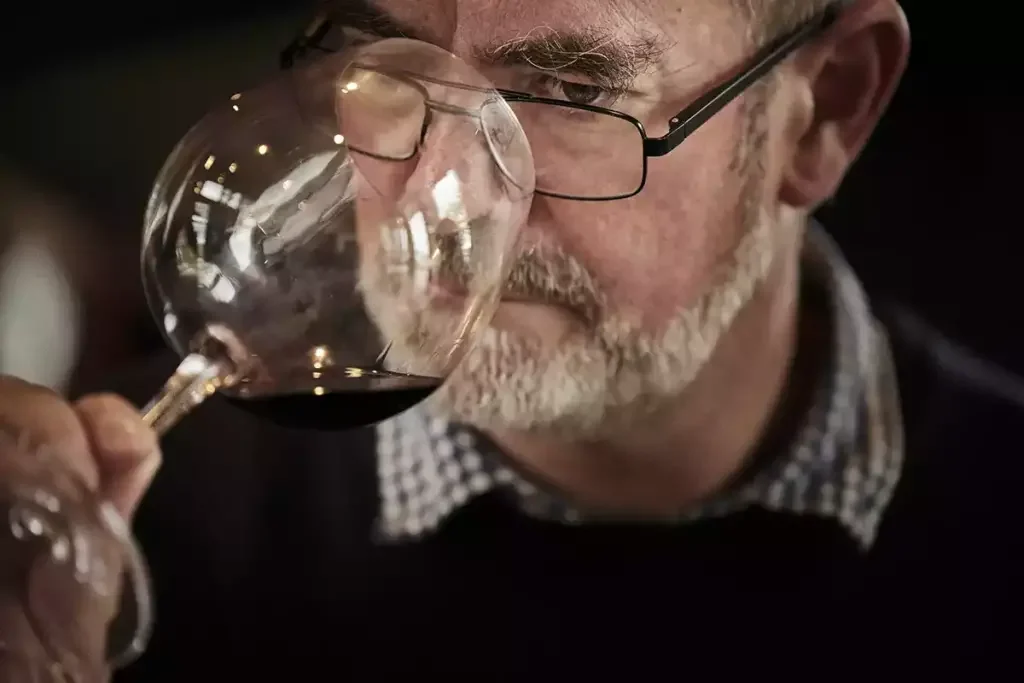
Ethereal (Temperate Years)
1994 Clonakilla Shiraz/Viognier Quality was superb but the yields dismal, a half tonne per acre, thanks to a bad frost in late October of the previous year. Three barrels only. 14% Pinot Noir and 4% Viognier. 100% whole-bunch, foot-trodden and fermented in open fermenters. Maturation in French oak (Seguin Moreau), two thirds new. This was the first year that all the oak was French.
A mature and quite fragrant red. Notes of spices, flesh, animal hides, and dried herbs. Quite a meaty style. Some complexity here but a wine ready for drinking now. Still alive and quite grippy, with a mid-length finish. Drink soon but no urgency. All that said, it was but a shadow of the bottle we looked at a decade earlier. | 92
1997 Clonakilla Shiraz/Viognier A warm summer followed winter rain. 5% Viognier, co-fermented. One third of the Shiraz was whole-bunch. 6.5% Pinot Noir, made discretely and blended into the final wine. A year maturing in Sirugue oak, 30% new.
Deep red, with an olive rim. A nose of barbecued meats, game, brambles, and dried herbs. There is a note like a freshly extinguished campfire. Maturity here, and some complexity. The palate really steps up to a new level. Bright acidity, good concentration, excellent length. It almost seems like a different wine on the palate—fresher and with more life than the nose indicated. Silky tannins. The palate suggests we have another four to six years ahead of us with this gem, but again, a pale comparison to the wine we saw a decade earlier, when it was the wine of the day. | 93
2001 Clonakilla Shiraz/Viognier This vintage kicked off a run of warmer years (apart from 2002). Tim considers it a benchmark. 30% whole-bunch and 7% Viognier. 13 days on skins, which included three days pre-ferment. A year maturing in a mix of one third new Sirugue, François Frères, and Bossuet. Tim describes this as “the wine that launched Clonakilla,” winning all manner of wine bling, including a “wine of the year” award. This wine was one of the last under cork—and it showed. Tim opened eight bottles for the tasting but could use only four.
An attractive maroon hue. The nose is redolent of flowers, spices, cherries, strawberries, coffee grinds, a hint of charcuterie, and new leather. The wine has balance, focus, and length, with satiny tannins. Finely crafted, it still has a decade or more ahead of it. Today, it is a slightly drier style than some and hints of rustic notes are emerging, but it is a superb effort. A decade earlier, it looked sensational. | 93
2004 Clonakilla Shiraz/Viognier 23% whole-bunch and 7% Viognier. A year maturing in Sirugue, François Frères, Taransaud, and Mercurey oak, with 35% new. This is Tim’s favorite wine, with its “wild, ethereal perfumes.”
Deep maroon. There are attractive red-fruit flavors, with tobacco leaves, dried herbs, and smoked meats. Still has energy, and there is real complexity. A seamless style but with great focus, too. This is really quite spicy/peppery. Fine tannins and good concentration on the lingering finish. So much to like about this wine. Should drink beautifully for at least the next ten years. It was also a favorite a decade ago. | 95
2006 Clonakilla Shiraz/Viognier Early rains here, but the growing season was a good one. 32% new oak. For Tim, “the archetypical Clonakilla approach, a lovely, even-year wine.” For me, one of the very best of the day.
Deep crimson, this is surely at its drinking peak at the moment, though it should continue to provide pleasure for at least a decade. Really appealing spicy aromas, with dried herbs, bay leaves, cherries, strawberries, other red fruits, and coffee grinds. There is complexity, a seductive texture, seamless structure, and ever-so-fine tannins. The palate has notes of coffee beans, aniseed, cocoa powder, and cherries. A fine line of acidity runs the length, while the intensity is maintained throughout. A very, very long finish. Superb now, but it does have years ahead. Love it, as we did at the previous event. | 96
2013 Clonakilla Shiraz/Viognier “A textbook year,” with a larger-than-average crop—most welcome after three lean harvests. 23% whole-bunch and 5% Viognier.
For me, a great wine and the star of the event. Dark cherry color. A glorious nose, seeming considerably younger than the 2012. Still offering the merest whiff of stone fruit. Rich, balanced, luscious, and long, there is real energy here. There are notes of cassis, aniseed, blueberries, and florals. A stunning nose, matched by the palate. So seductive, with cashmere tannins and a gentle plushness. Wonderful length, immaculate balance. This still has 10–15 years ahead of it. | 99
2014 Clonakilla Shiraz/Viognier This was seen as a vintage of extremes, with four days at the end of January exceeding 104°F (40°C). 23% whole-bunch. A high-profile local winemaker shared his thoughts on these wines: “Power and concentration but detail and delicacy—these are effortless wines.”
A lovely red/garnet hue, the aromas leaping from the glass. There is still evidence of Viognier here. Cassis and coffee bean, smoked meats, and spices. This is a wine that really does need some time, even at this stage. Finely balanced, good intensity, soft tannins, a lingering and persistent finish. This will be even better in 10–15 years. Really good. | 96
Glow (Warm Years)
1998 Clonakilla Shiraz/Viognier The lead into harvest saw “a long series of very warm days.” One third whole-bunch and 5% Viognier, co-fermented. A year in oak, 30% of which was new Sirugue, the remainder François Frères.
Red with a brown edge, and some not inconsiderable sediment here. The aromas weave through cigar boxes, brambles, tobacco leaves, warm earth, and dried herbs. Quite mature, though still more than clinging to life. A mid-length style, finely crafted with soft tannins on the finish, it still has time, though there is no reason not to consume now any bottles you might have. A decade earlier, the suggestions were that this was exactly the direction in which it was headed. | 90
2003 Clonakilla Shiraz/Viognier The year of drought. This was harvested March 13–14. Usually picking occurs mid-April to early May. 30% whole-bunch, 6% Viognier. 12 months in one third new Sirugue oak, the remainder between François Frères and Bossuet.
Deep maroon hue. This is not from the most elegant end of the Clonakilla spectrum, being a little burly with a gentle fade. Notes of campfire, cherries and other red fruit, aniseed, dried herbs, bay leaves, and warm earth. Quite bright on the palate, it still exhibits bags of life. Decent length and intensity, but it does show that slow fade, so might perhaps be best drunk soon. The notes reflect what we saw a decade previously, though it is now a little further down the track. | 92
2007 Clonakilla Shiraz/Viognier A serious frost in November was a bad start, and the crop was down 92% on the previous vintage. Harvest was the earliest ever here, starting on February 27. Only seven barrels were made, and one of these was declassified (though Tim has no doubt that they could have sold it), hence a total of just 1,800 bottles. 70% new oak, 23% whole-bunch and 6% Viognier. Customers were limited to just four bottles, with the full production sold within 36 hours. Anyone who managed to get hold of this wine will be very happy.
Deep blood-red, this is beautifully composed. Alluring dark-cherry notes, violets, smoked meats, and more. A plush note to the structure, seamless and supple. Everything is finely balanced, with a line of acidity running the length and satin-like tannins. Exceptional length. Wonderful drinking. It was stunning stuff a decade earlier—and it is still stunning stuff. | 95
2009 Clonakilla Shiraz/Viognier At the time, Tim saw this as “Canberra’s greatest red year to date,” and the wine certainly reflects that. February was “blistering,” but the continentality of the region’s climate saw the temperatures dropping by 27–36°F (15–20°C) at night. 22% whole-bunch, 5% Viognier.
Dark cherry in color. A seamless texture, with fine integration, bright acidity, boundless energy, impeccable balance, and excellent length. The flavors move through cassis, cocoa powder, dried herbs, aniseed, blueberries, and delicatessen meats. Underlying power here, with wonderfully fine tannins. Still a decade to go. Elegance with power. A decade earlier, Tim had no hesitation in describing this as the “greatest wine we have ever made.” It must still sit with the very best. | 96
2016 Clonakilla Shiraz/Viognier El Niño ensured that this was a dry year, though there were relieving bursts of rain, especially at the end of January. Yields were high. Picked very early—February 29. As Tim said, it was still exhibiting primary characters.
An attractive crimson color. Youthful aromas here, and the first real hint of Viognier in this bracket, though it is well on the way to full integration. Flowers, spices, cherries, raspberries, a hint of an orange-rind note, and tobacco leaves. Good focus, though the palate here is perhaps not quite as long as we see in the very best wines. Nevertheless, it should still drink well for a decade. | 93
2018 Clonakilla Shiraz/Viognier A great year for many regions in Australia, though a January hailstorm did not help here, with some heavy rain just before “final ripening.” 15% of the crop was ruined. Then a “perfectly warm autumn.” Despite the handicaps, this is a stunning wine.
A purple hue, and the wine simply explodes with aroma and flavor. Flowers, chocolate, bay leaves, cocoa powder, black cherries, aniseed, and a hint of eucalyptus. Gorgeous aromatics. A seamless texture, balanced flavors, fine acidity, and great length. A wine that will offer so much over the next 15 years and probably longer. | 97
2019 Clonakilla Shiraz/Viognier Drought made its impact felt. The bore-fed drippers came to the rescue, before good rain in January and February. Yields were lower than usual, down around 20%. 6% Viognier, a year and a half in barrel. This was a departure for the team, since every other wine spent closer to 12 months in oak.
A magenta hue. The nose is obviously very young but redolent of chocolate, tobacco leaves, cassis, mocha, and coffee beans. There is real elegance here—another superb example of how good these wines are. Great length, balance, and the silkiest of tannins. This is the first of the wines where any oak influence is at all apparent, but it is still early days, and one would assume that integration will soon be complete. Elegance and intensity. This has a good 20 years in it. | 96
Tasted separately (recently)
2022 Clonakilla Shiraz/Viognier A cool season and a longer-than-usual ripening period. Between 20% and 35% whole-bunch, co-fermented with 5% Viognier. Wild yeasts and a two- to three-week maceration before pressing into French oak, one third new.
It is evident that the cooler years show more pepper and spice. That would suggest that this was a very cool year indeed. A nose like an Arabian spice bazaar. Everything from white pepper to cinnamon; nutmeg, cloves, dry herbs, and more. Leather and tobacco leaves. This is fresh, with good acidity and serious length, though it is perhaps leaner than some. The tannins are extremely fine and yet ever so slightly grainy. Intensity is maintained throughout. Ten to 15 years of pleasure ahead here. At the moment, it definitely benefits from decanting or, at the very least, time in the glass, and it is even better the following day. | 96



